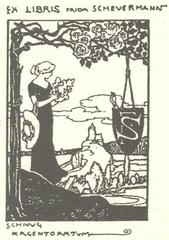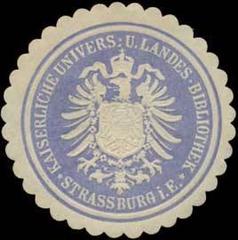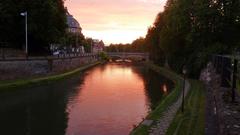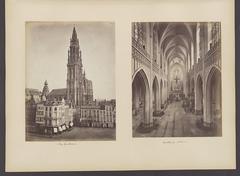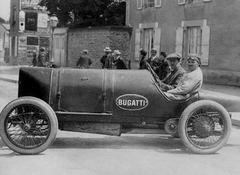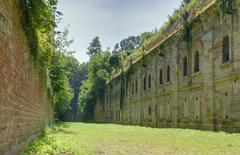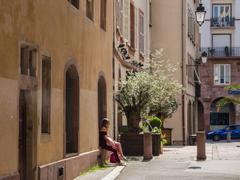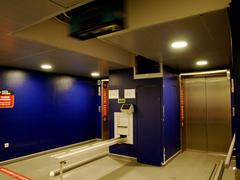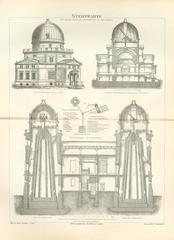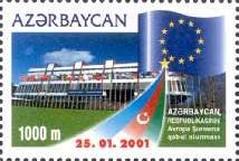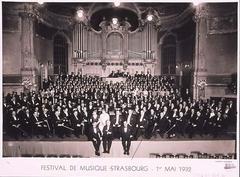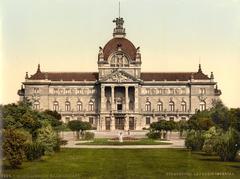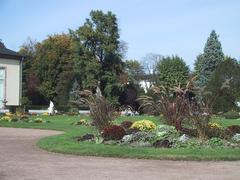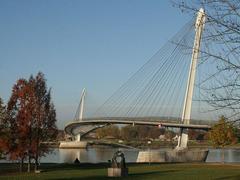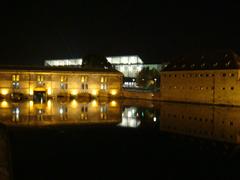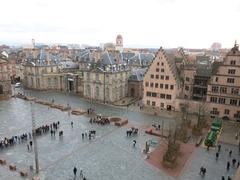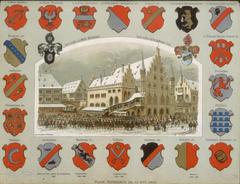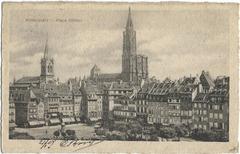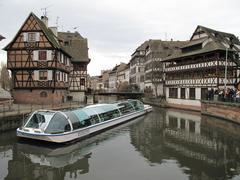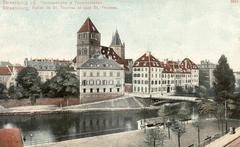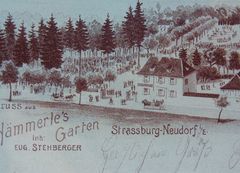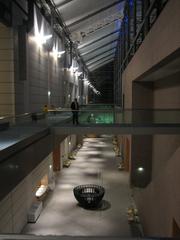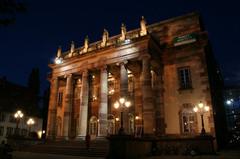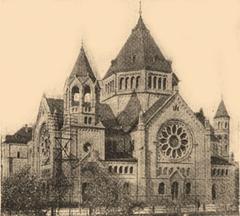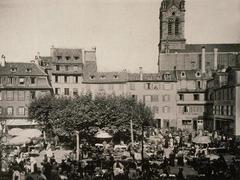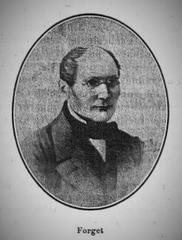
Statue D’Adrien De Lezay-Marnésia: Visiting Hours, Tickets, and Historical Significance in Strasbourg, France
Date: 03/07/2025
Introduction
Strasbourg, a city renowned for its layered history and vibrant culture, is home to many significant public monuments. Among these, the Statue D’Adrien De Lezay-Marnésia stands out as a distinguished tribute to Baron Paul Adrien François Marie de Lezay-Marnésia (1769–1814), a key French statesman and administrator. Erected on the scenic Quai Lezay-Marnésia in the heart of Strasbourg, this bronze monument by noted 19th-century Alsatian sculptor Philippe Grass offers visitors a blend of artistic mastery and historical narrative. The statue not only immortalizes Lezay-Marnésia’s achievements but also reflects the enduring connection between the city and its leaders. This guide details the statue’s origins, artistic significance, visiting hours, accessibility, and practical travel tips—ensuring a rich and informed visit for every traveler.
For up-to-date information, consult the Strasbourg Tourism Website and learn more about Philippe Grass.
Contents
- Overview and History of the Statue
- Biography: Adrien de Lezay-Marnésia
- Philippe Grass: Artistic Vision and Legacy
- Statue Location and How to Get There
- Visiting Hours and Accessibility
- Ticket Information and Guided Tours
- Nearby Attractions in Strasbourg
- Artistic Style and Symbolism
- Historical Significance and Restoration
- Travel Tips and Visitor Amenities
- Frequently Asked Questions (FAQs)
- Further Resources and Official Links
Overview and History of the Statue
The Statue D’Adrien De Lezay-Marnésia, created by Philippe Grass in the mid-19th century, commemorates one of Strasbourg’s most impactful administrators. Originally commissioned to honor Lezay-Marnésia’s civic legacy, the statue has withstood wartime destruction and has been faithfully restored to retain its place in the city’s historic center.
Prominently located on Quai Lezay-Marnésia, the monument faces the former prefecture building, symbolizing the prefect’s longstanding administrative and social influence on Strasbourg and Alsace (archi-wiki.org).
Biography: Adrien de Lezay-Marnésia
Baron Paul Adrien François Marie de Lezay-Marnésia was a French nobleman, diplomat, and administrator whose career spanned the tumultuous Napoleonic era. As prefect of Bas-Rhin from 1810, he initiated critical reforms in infrastructure, agriculture, education, and public health, including the introduction of smallpox vaccination. His leadership was marked by pragmatism, compassion, and a deep bond with the Alsatian people. His sudden death in 1814, resulting from an accident with his ceremonial sword, was widely mourned and cemented his legacy in the region (Wikipedia, annales.org).
Philippe Grass: Artistic Vision and Legacy
Philippe Grass (1801–1876) was a preeminent Alsatian sculptor whose neoclassical style was enriched by Romantic expressiveness. After studying in Paris and working on the restoration of Strasbourg Cathedral, Grass became known for his ability to combine historical fidelity with emotional resonance. The Statue D’Adrien De Lezay-Marnésia, completed in 1856 and inaugurated in 1857, exemplifies Grass’s commitment to immortalizing local historical figures with dignity and nuance (biographs.org, HAL Thesis).
Statue Location and How to Get There
Address and Setting
The statue is situated at the intersection of Quai Lezay-Marnésia and Rue de la Nuée-Bleue, adjacent to the Ill River, in Strasbourg’s UNESCO-listed Grande Île. Set within a landscaped square, the location combines accessibility with scenic beauty, offering benches and shaded areas for visitors.
Directions
- Tram: Lines B, C (Gallia Station, 5-minute walk); Lines A, D (Homme de Fer Station, 10-minute walk)
- Bus: Lines 30, C1, C9, 10, C6, 15 (Saint-Guillaume Stop, 3-minute walk)
- Bike: Velhop bike rental stations are nearby; cycling is encouraged in the city center
- Car: Public parking garages at Parking Austerlitz (7-minute walk) and Parking Opéra Broglie (10-minute walk)
For real-time transit updates, use Moovit Strasbourg.
Visiting Hours and Accessibility
- Hours: The statue is outdoors and accessible at all times, year-round.
- Admission: Free; no ticket required.
- Accessibility: The site features smooth pavements, curb cuts, and nearby ramps, making it wheelchair and stroller friendly. Low-floor trams and buses serve the area.
Ticket Information and Guided Tours
There is no fee to visit the statue. Guided tours of Strasbourg’s historical center, often including the statue as a highlight, can be booked through the Strasbourg Tourist Office. These tours provide rich context on Lezay-Marnésia’s life, the statue’s art, and the urban history of Strasbourg.
Nearby Attractions in Strasbourg
While visiting the statue, consider exploring:
- Strasbourg Cathedral: A masterpiece of Gothic architecture, ~10-minute walk
- Place Kléber: Features General Kléber’s monument, also by Philippe Grass
- Palais Rohan: Baroque palace housing major museums
- La Petite France: Picturesque historic district with canals and timbered houses
- Musée des Beaux-Arts: Regional art and sculpture collections
These sites are within easy walking or cycling distance, making them ideal additions to your itinerary.
Artistic Style and Symbolism
Philippe Grass’s statue renders Lezay-Marnésia in dignified, formal attire, symbolizing his authority and civic virtue. The prefect is depicted standing upright, hand resting on a scroll—representing his administrative achievements and service. The facial expression is contemplative, suggesting wisdom and empathy. Inscriptions on the base reinforce themes of local pride and regional identity, notably:
“Les Alsaciens m’ont prouvé qu’ils n’ont point dégénéré et je suis fier d’être né parmi eux”
(“The Alsatians have proven to me that they have not degenerated, and I am proud to have been born among them.”)
(pokaa.fr, judrand.com)
Historical Significance and Restoration
The statue is a symbol of Strasbourg’s civic values and the city’s resilience. Originally inaugurated in 1857, it was destroyed during World War II and replaced by a faithful copy in 1949. Restoration efforts have preserved both the statue and its setting, with repairs visible in areas such as the right leg—testifying to the monument’s turbulent history and the city’s dedication to heritage (archi-wiki.org).
Travel Tips and Visitor Amenities
- Best Visiting Times: Spring and autumn offer pleasant weather and fewer crowds; early morning or late afternoon provides optimal lighting for photography.
- Amenities: Benches, shaded areas, and nearby cafés. Public toilets are available at Place Broglie and Place de la République.
- Safety: The area is safe, with regular police patrols and good lighting.
- Language: Signage is primarily in French; English is available at major tourist points.
- Weather: Strasbourg’s climate can be variable; bring an umbrella or rain jacket as needed.
Frequently Asked Questions (FAQs)
Q: What are the visiting hours for the Statue D’Adrien De Lezay-Marnésia?
A: The statue is accessible at all times, year-round, free of charge.
Q: Is there an entrance fee or ticket required?
A: No, visiting is free.
Q: Are guided tours available?
A: Yes, bookable through the Strasbourg Tourist Office and local operators.
Q: How do I get there by public transport?
A: Trams B, C, A, D and buses 30, C1, C9, 10, C6, 15 stop nearby.
Q: Is the site accessible for people with reduced mobility?
A: Yes, the area is fully accessible.
Q: Can I take photographs at the statue?
A: Absolutely; photography is encouraged, especially during golden hour.
Further Resources and Official Links
- Official Strasbourg Tourism Website
- Statue of Adrien de Lezay-Marnésia, Archi-Wiki
- Philippe Grass Biography
- Moovit Strasbourg Transit Guide
- Les Statues à Strasbourg, Pokaa.fr
- Annales.org, Adrien de Lezay-Marnésia
- Happy Strasbourg: Statues and Secrets
- Philippe Grass Thesis, HAL
- Wikipedia – Adrien de Lezay-Marnésia
Conclusion
The Statue D’Adrien De Lezay-Marnésia is more than a remarkable work of public art—it is a living testament to Strasbourg’s historical depth, artistic excellence, and civic spirit. Its central location, free access, and historical resonance make it a must-visit for anyone exploring the city. Enrich your visit by exploring nearby landmarks and consider joining a guided tour for deeper insight. For the latest updates and curated travel tips, download the Audiala app and follow us on social media. Experience firsthand the heritage and artistry that define Strasbourg.


